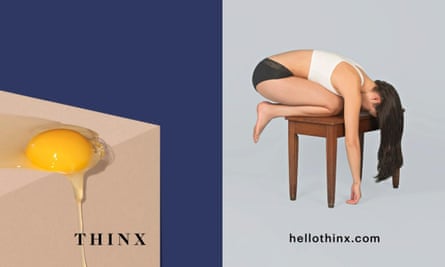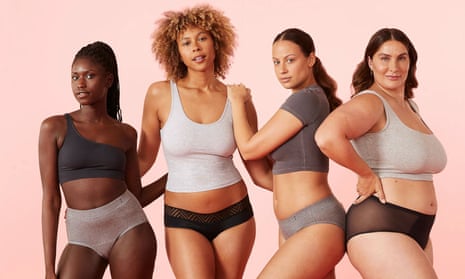Tasha Gjesdahl has spent hundreds of dollars on her Thinx period underwear. She’s been a customer for over five years, mostly because she finds the panties more comfortable than pads, plus she can wash and reuse them every cycle.
“They provide a sense of security so I don’t worry about leaks or bleeding through clothes,” said Gjesdahl, who is 28 and lives in Wisconsin. She started using the brand’s “super absorbent” style after she bled for weeks post-partum. The underwear, made with cotton, nylon and elastane, is leak-resistant and can hold up to five regular tampons’ worth of blood.
“[Thinx was] the only pair of underwear I wore for three or four weeks after my child was born,” Gjesdahl said. “It was a relief to not have to wear the giant pads the hospital provides.”
But her relief turned to disappointment this week after news broke that the New York-based brand had settled a class-action lawsuit regarding its supposedly “organic, sustainable and non-toxic” underwear.
Though Thinx denies “improper or unlawful” behavior, the brand faced allegations in court “regarding the presence of short chain per-and polyfluoroalkyl substances (‘PFAS’)”, also known as “forever chemicals”.
According to the EPA, PFAS are “widely used, long lasting chemicals, components of which break down very slowly over time”. These chemicals have been found “in the blood of people and animals all over the world” and “may be linked to harmful health effects in humans”. That said, researchers still do not know just how harmful PFAS are to humans, or exactly how much people are exposed to them.
In the class-action suit, Thinx said that PFAS “have never been a part of its product design, and that it will continue to take measures to help ensure that PFAS are not intentionally added to Thinx Period Underwear at any stage of production”.
Customers who submit valid claims to buying Thinx products between 2016 and 2022 can receive $7 per purchase for a maximum of three purchases.
Thinx brands itself as a sustainable alternative to single-use pads and tampons. Its website pledges that the underwear is made “carefully and consciously, from [our] sustainable manufacturing processes to ethical working conditions”. Thinx also has a line for children experiencing their first few cycles, called Thinx Teen.
A reported one million people use Thinx products. Now, consumers such as Gjesdahl wonder if they’ve unknowingly exposed themselves to toxic chemicals – and what period product they will reach for next.
“I’m disappointed because I love these products and now I’m scared about the impacts that PFAS and silver nanoparticles might have had on my health that I’m not experiencing yet, like cancer,” Gjesdahl said.
On Twitter, other customers also directed their anger at the brand. “This is trash and the settlement amount is trash, thinx costs so much money … why is it so hard to find safe menstrual products?” one user wrote.
“Nothing quite like reading about the Thinx lawsuit while wearing a pair,” tweeted another.

Brianna, a 34-year-old from Minnesota, has shopped at Thinx for a little over a year. She calls the products “game-changing” and said the underwear made her period more manageable and less noticeable. But she does not feel safe using the products now, and feels defeated having to find another go-to menstrual product when so many of them do not work for her anatomy. (Brianna asked that her last name not be used.)
“Finding a menstrual product you like is so insanely frustrating because not everything works for everybody,” Brianna said. “Period products are not cheap, they vary widely from brand to brand, and even though I’ve had a period for over two decades, I’m still finding what works for me.”
Representatives for Thinx did not respond to a request for comment.
For many, the search for a suitable menstrual product goes on. Pads can feel bulky and show through tight clothing. Tampons are a bit less cumbersome, though like pads they are single-use products that build up waste and can also include harmful chemicals such as phthalates and dioxins. Menstrual cups are considered an eco-friendly and cost-effective alternative, though inserting these silicone or rubber devices can be messy and they can be ill-fitting.
When over 1.8 billion people around the world menstruate each month, why is it so hard for them to find quality period products? Chris Bobel, a professor of gender and sexuality studies at the University of Massachusetts Boston, says it has to do with menstrual stigma. As long as a device obscures the fact that a woman has her period, she may feel grateful for the coverage, not skeptical or curious about how it works.
“Our socialized priority is to conceal our menstruating bodies, and not to question the types of products that we use,” Bobel said. “It really is a perfect set-up for the industry to take advantage of us and exploit our desperation to pass as non-menstruating.”
Though today’s menstruators are too young to have experienced the panic over toxic shock syndrome linked to the ultra-absorbent Rely tampons Procter & Gamble sold in the 1970s, that fear of harmful period products looms large. “A startup [like Thinx] can take advantage of that, even if they represent themselves as different from the major manufacturers, like David in the face of Goliath,” Gobel said.
And that’s certainly part of Thinx’s brand. The company differentiated itself from the Tampaxes of the world with in-your-face ads, which sometimes featured images of tampon strings or yonic fruit. Former fans like Brianna won’t be sticking around for the next boundary-pushing campaign. “Now, I’m back to square one and out hundreds of dollars,” she said.
